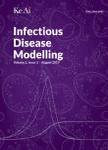The role of super-spreaders in modeling of SARS-CoV-2
作者机构:School of Science and TechnologyÖrebro University70182ÖrebroSweden Centre for Mathematical SciencesLund UniversityBox 11822100LundSweden Hellenic Mediterranean UniversityP.O.Box 1939GR-71004HeraklionGreece Centrum för forskning och utveckling(CFUG)Region GävleborgSweden
出 版 物:《Infectious Disease Modelling》 (传染病建模(英文))
年 卷 期:2022年第7卷第4期
页 面:778-794页
学科分类:1002[医学-临床医学] 100201[医学-内科学(含:心血管病、血液病、呼吸系病、消化系病、内分泌与代谢病、肾病、风湿病、传染病)] 10[医学]
基 金:financial support from Carl Tryggers foundation and RR-ORU-2021/2022
主 题:COVID-19 Compartmental models SEIR SIR Offspring distribution for SARS-CoV-2
摘 要:In stochastic modeling of infectious diseases,it has been established that variations in infectivity affect the probability of a major outbreak,but not the shape of the curves during a major outbreak,which is predicted by deterministic models(Diekmann et al.,2012).However,such conclusions are derived under idealized assumptions such as the population size tending to infinity,and the individual degree of infectivity only depending on variations in the infectiousness *** this paper we show that the same conclusions hold true in a finite population representing a medium size city,where the degree of infectivity is determined by the offspring distribution,which we try to make as realistic as possible for *** particular,we consider distributions with fat tails,to incorporate the existence of *** also provide new theoretical results on convergence of stochastic models which allows to incorporate any offspring distribution with a finite variance.



